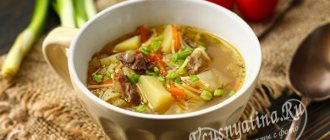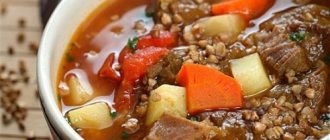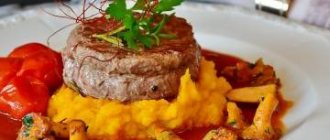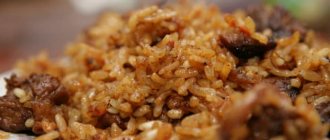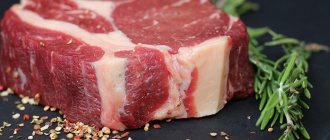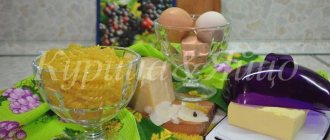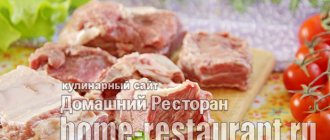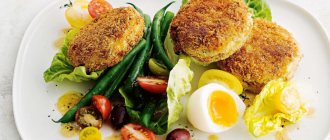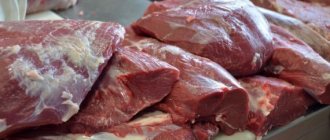We do not live by steak alone, and not by tenderloin alone. In the carcass of a cow, calf, or ram, there are many other parts that can also be cooked deliciously. But if the tenderloin is usually prepared easily and it is quite difficult to spoil it, then with other parts skill may be necessary. Especially with those who worked a lot and hard during the animal’s life. And these, surprisingly, are the cheeks. Cheeks and lips are excellent meat, but it takes a long time to cook. Actually, the cooking time is practically the only thing you need to know about the cheeks. If you stew them correctly, you will get the most tender meat, aromatic, soft and not at all greasy. We asked the capital's chefs about how to properly cook cheeks.
Related article: Salt correctly, fry correctly. How to cook brains, liver and tongue
Alessio Gini, chef at AV Bistro:
The cheeks need to be cooked for a long time. But there is a danger here: if you overexpose them, they will fall apart into fibers. In the restaurant we make the cheeks using sous vide technology, that is, we seal them in a vacuum and steam them at low temperature for 10-12 hours. You can also cook delicious cheeks at home. I would recommend using a casserole dish or other pan with a heavy lid that can go in the oven. The cheeks must first be fried with celery, onions and carrots, poured with tomato sauce, covered with a heavy lid so that the liquid does not evaporate, and put in the oven at a temperature of 180-200 degrees. About 2.5-3 hours.
Ignat Kulikov, chef of Dante kitchen+bar:
The cheeks and tongue are muscles that work a lot. It doesn’t make much difference which animal cheeks you cook: veal, cow, lamb. The technology is approximately the same. You won't be able to cook them quickly. This back muscle can be quickly grilled and it will be delicious. And the cheeks need to simmer for a long time. The easiest thing is to cook them in the oven. I usually take onions, carrots, celery, chop them, fry them a little and add wine, which I evaporate completely. Then I add punched tomatoes (you can take them in their own juice without the skin), a little broth or water, and put the cheeks in there. The water must be hot. The dishes need to be covered very well with foil and the cheeks should be simmered at a temperature of 160-180 degrees for at least two and a half hours. And you will get soft cheeks. There is no way to speed up the process.
You can try cooking the cheeks in a slow cooker. You need to select the “stewing” mode, with a temperature of 85 degrees, and simmer your cheeks for 10-12 hours. The sauce can be made the same as we did in the oven.
Igor Bednyakov, chef of the Bochka restaurant:
Cheeks are structural and quite dense meat; you can’t just fry it. I make it sous vide and then simmer it in additional sauce. In sous vide, products are cooked in their own juices; at low temperatures, the protein does not coagulate, so at the end you get meat that you can chew with your lips. You can also make something like sous vide at home. Vacuum sealers are now sold; you can seal the meat and cook at low boil for quite a long time. Or pack the meat in a tight bag so that water does not penetrate there, and cook it like that. You need to cook for a long time, about 3 hours. This is what we did before special sous vide machines appeared.
Veal cheeks with broccoli puree
Ingredients: veal cheeks 400 g, vegetable oil 130 ml, water 1 l, onion 3 pcs., salt, black pepper, broccoli, celery stalk, butter 120 g, parsley, red wine 250 ml, Demi-glace sauce (sauce cooked from beef bones with vegetables) 150 g, mussels 150 g, flour 47 g, celery root.
Method of preparation: put the frying pan on the fire. Add vegetable oil. Place the veal cheeks on a paper towel to remove excess moisture. Peel and chop the onion. Place the cheeks on the heated frying pan. Peel 2 more onions and cut into rings. Separate the rings from each other and bread them in flour. Turn the cheeks over and add chopped onions to them. Let's add salt and pepper. Pour in boiling water. Simmer for 3 hours.
Cut off the broccoli florets. Place the saucepan on the fire. Lay out the broccoli and pour in a little boiling water. Chop the celery stalks and root. Add to broccoli. Add butter. Let's add salt and pepper. Cover with a lid.
Prepare the sauce. Place the saucepan on the fire. Pour in red wine. Let's pepper it. Lay out the mussels. Let's add some salt. Place the frying pan on the fire. Add vegetable oil. Fry onion rings breaded in flour. Make sure that the oil does not overheat, otherwise the onions will burn. When the wine boils in the saucepan, add demi-glace. Mix. Place the fried onion rings on a paper towel to drain excess fat. Place the cheeks in the wine sauce along with the stewed onions. Reduce heat.
Drain almost all the water from the broccoli and celery. Mash with a masher until pureed. Add butter. Mix.
Spread the puree through the serving ring. Place veal cheeks and mussels around. We put the ladle on the fire. Add a little flour and butter. Stir vigorously. Pour in a little sauce. Stir until the sauce becomes thick. Pour the sauce over the dish. Remove the serving ring. Garnish with fried onion rings and parsley.
Classic recipe
Beef cheeks, the recipe for which involves prolonged stewing, are recommended to be first fried until golden brown.
In the classic version, red wine and fresh aromatic herbs are added to them.
What ingredients will you need?
- 2 beef cheeks;
- 1 onion, diced;
- 1 carrot, cut into pieces;
- 1 stalk of celery, cut into pieces;
- optional: other aromatic vegetables such as leeks and garlic;
- 2 tbsp. l. tomato paste or fresh tomato puree;
- 1 tbsp. red wine;
- 3-4 tbsp. beef broth (enough to cover beef cheeks);
- a few sprigs of fresh thyme or rosemary;
- 2 bay leaves;
- olive oil;
- salt and coarsely ground pepper;
- 2 tsp. a thickener such as flour, cornstarch or arrowroot powder.
Step-by-step cooking process
- Pat the beef cheeks dry with a paper towel to remove excess liquid and season with plenty of salt and coarse pepper.
- Add a little olive oil to a large heavy-bottomed saucepan or ovenproof casserole dish, heat over high heat and sear the meat on both sides until light brown and caramelized, then remove and set aside.
- Pour a little more olive oil into the same pan and fry the vegetables - onions, carrots, celery, leeks and/or garlic.
- Add tomato paste or puree and simmer until the raw tomato taste disappears.
- Place the beef cheeks back into the pan, add red wine and reduce heat.
- Pour in the broth to completely cover the beef cheeks and let the mixture boil, add a few sprigs of fresh thyme or rosemary and a bay leaf.
- Cover the pan with a lid or wrap the top tightly with foil and simmer over low heat for 3-4 hours, or place the container in the oven preheated to 160°C and cook for the same amount of time. You can also transfer the beef cheeks to a slow cooker and cook for 4-6 hours on the stew mode.
- When the meat is ready (it becomes easy to cut with a spoon), transfer it to a plate.
- From the remaining liquid, remove pieces of vegetables, herb sprigs and bay leaves, strain it into a smaller saucepan, heat over low or moderate heat, add a thickener (flour or starch) and cook over low heat until thick.
- Serve beef cheeks with sauce.
Beef cheeks in a slow cooker
Before putting the beef cheeks into the slow cooker, keep them in the marinade. The marinade recipe can be anything, the main thing is that it softens tough meat well. Fruit marinades cope with this task with a bang. Read recipes for marinades with fruits here. Tasty and tender bull cheeks will be obtained if you hold them in a beer marinade. Read the recipe here. And, of course, don’t forget about the classic – wine marinade for meat. We have described many marinade recipes that contain wine here. How long to marinate bull cheeks? If it is a light marinade with herbs and wine, marinate the meat overnight. But you shouldn’t keep meat in a fruit marinade for a long time. A couple of hours will be enough. Cooking beef cheeks in a slow cooker begins with pre-frying them. Blot the meat from moisture and place it in the multicooker bowl, selecting the “frying” mode. Cook until crusty for 15-20 minutes. Add prepared vegetables and spices. We recommend taking a bouquet of Garni or separately a bay leaf, sprigs of rosemary and thyme. Add star anise, anise or cloves to taste. Don't forget to add liquid: water, broth, wine or beer - choose to your taste. Close the multicooker and set the stewing or simmering mode for at least two hours. After a couple of hours, check the readiness of the cheeks. They should fall freely into fibers. If desired, add potato wedges, pasta, rice or bulgur to the meat - this way you will get meat with a side dish in a flavorful gravy. If you decide to cook veal cheeks in red wine in a slow cooker, take Jamie Oliver's recipe as a basis. We described it in detail in this.
Time, patience, low temperature. How to cook beef cheeks
We do not live by steak alone, and not by tenderloin alone. In the carcass of a cow, calf, or ram, there are many other parts that can also be cooked deliciously. But if the tenderloin is usually prepared easily and it is quite difficult to spoil it, then with other parts skill may be necessary. Especially with those who worked a lot and hard during the animal’s life. And these, surprisingly, are the cheeks. Cheeks and lips are excellent meat, but it takes a long time to cook. Actually, the cooking time is practically the only thing you need to know about the cheeks. If you stew them correctly, you will get the most tender meat, aromatic, soft and not at all greasy. We asked the capital's chefs about how to properly cook cheeks.
What it is
Beef cheeks are part of the carcass of a cow. They are part of the facial muscle that the animal uses to chew food. When cutting, the cheeks are cut out, skinned, washed well and sent for sale. Of course, this is far from the most expensive part of the carcass, but very attractive to gourmets.
It is best to make the cheeks into a stew as they will take at least eight hours to prepare. Modern housewives widely use a multicooker or pressure cooker, in which the meat turns out to be especially tender.
This cut is not suitable for other types of cooking because it has tough fibers that need to be thoroughly steamed to ensure that the meat ends up tender.
Veal cheeks in wine
#1 Bogutskiy
Greetings, dear connoisseurs of delicious food!
I think this recipe will be interesting in the current economic realities
I’ll immediately quote the words of the author of the recipe: “This part of the carcass (cheek) has long been popular with modern chefs who are trying to get away from the stereotypes of visitors and expensive cuts such as tenderloin and standard steaks in order to show the advantages and often unique properties of cheap and “non-prestigious” parts.”
I searched for a long time. same as the seal. Sellers say that the heads are sold as dog food or all the meat is minced.
Kinds
Depending on the age of the animal, cheeks can be divided into beef and veal. The former are more meaty and have to be cooked for a long time to make the product suitable for consumption. The color of the meat is dark and rich, it is from this that one can understand that the cow was an adult, and accordingly, her facial muscles have developed sufficiently.
Veal cheeks are not so tough and they are stewed less often, since the young animal has not yet eaten grass, but was fed mainly on mother's milk, since heifers are slaughtered at four months of age. The color of the meat is soft pink, the fibers are not so elastic and tough. Beef cheeks are classified as offal. If earlier it was easy to get the product in meat stores, today it appears less and less on the shelves.
Risotto with baked pumpkin
Beef cheeks, the recipe for which is prepared in a very unusual form, is published below, go well with rice. Risotto in this version turns out original with a bright taste, since it contains pumpkin.
Ingredients
For the dish you need to take:
- rice – 130-140 g;
- beef cheeks – 100-120 g;
- filtered water – 400 ml;
- cream – 1 tbsp;
- parmesan – 40-45 g;
- sibulet onion, soy sauce and honey – 5-7 g each;
- fresh pumpkin (already peeled) – 120 g;
- Hoisin sauce – 3 ml;
- salt, vegetable oil, pepper.
Cooking cheeks in sauce
Wash the meat and dry it with paper towels. Then sprinkle with ground white pepper and roll in wheat flour. Pour half the olive oil and fifty grams of butter into a non-stick frying pan. Heat over the fire and fry the meat on both sides. Then place the fried veal cheeks in a refractory baking dish and evenly pour five hundred milliliters of the prepared Demi-glace sauce on top. Place in an oven preheated to one hundred and ninety degrees for about two and a half hours.
While the veal cheeks are baking in the sauce, you need to prepare the remaining ingredients. Wash all the vegetables indicated in the recipe well under the tap. Next, cut the tomatoes into rings, and cut the zucchini and eggplant, without peeling, into half rings. Drizzle with olive oil, salt to taste, add thyme sprigs, a pinch of ground pepper and oregano, mix all ingredients. Carefully wrap in a sheet of baking foil, place on a baking sheet and place in the oven at a temperature of one hundred and ninety degrees for half an hour to bake.
All that remains is to cook the mushrooms and onions. Place fifty grams of butter in a frying pan and put on fire. When the frying pan is hot, add finely chopped onion and fry lightly, and then add the champignons cut into slices. Fry until all the moisture has evaporated from the mushrooms.
Remove the pan with the veal cheeks in the sauce from the oven. Remove the meat from the sauce and place in a frying pan with mushrooms and onions. Add fifty grams of butter and simmer over low heat until the desired consistency. After preparing all the ingredients, you need to prepare the dish. Place veal cheeks with champignons and oven-baked vegetables in portions on a large flat plate. A tender and juicy dish can be served to the table.
With bulgur
Beef cheeks cooked with bulgur are not only tasty, but also healthy.
This recipe will feed the whole family a hearty lunch or dinner.
Ingredients
For the dish you need to take:
- bulgur – 400-420 g;
- beef cheeks – 800-850 g;
- fresh beetroot – 60 ml;
- butter – 10 g;
- chicken broth - 1 tbsp;
- Demi Glass sauce – half a kilo;
- white onion – 1 head;
- Barbecue sauce – 140-150 g;
- garlic oil – 2 tbsp. l.;
- garlic – 2 cloves;
- ginger root – 1 cm;
- balsamic cream – 1 tsp;
- dry chicken broth – 35-40 g;
- pepper and salt – 1 g each;
- water and soy sauce.
Sequencing
Stages:
- Beef cheeks must be washed, dried, and then first fried until lightly browned, then poured with a mixture of water and soy sauce (proportions to taste) and simmered under the lid until soft for 2.5-3 hours. To make the offal soft, you need choose a frying pan with a thick bottom.
- You will need to rinse the bulgur, pour boiling water over it and leave until completely swollen, then drain the water, salt the grains and cool to taste.
- Finely chop the onion and garlic, grate the ginger, and then fry the products together in butter.
- Next, the mass from the last step is diluted with broth, balsamic and Demi Glass sauce are added to it. After about a quarter of an hour of simmering the sauce over low heat, all that remains is to add dry broth, garlic oil, BBQ sauce, salt and pepper to taste and cook for another 7-8 minutes.
When serving food to the table, first the cheeks, cut into small pieces, are laid out on a plate. Nearby is a portion of bulgur. The entire dish is topped with the sauce from step 4.
Braised beef cheeks
2 servings
2 beef cheeks 1/2 leek (green part only) 2 carrots 1 onion 1 celery root 2 heads of garlic 200 g dry red wine bay leaf thyme sprig 2 tbsp. tomato paste 1 tbsp. butter 1 tbsp. flour 1/2 tbsp. pink peppersaltblack pepper
for puree: 1 celery root 2 potatoes 1 onion thyme sprig 2 tbsp. melted butter salt
This is Catherine Park in Pushkin, near St. Petersburg. This is where the Admiralty restaurant is located.
And this is chef Sasha, who kindly agreed to conduct a master class on preparing one of his signature dishes for the editors of our modest culinary blog (and therefore for all of you).
What I liked about this recipe is its simplicity and accessibility. The only difficulty may be the “hunt” for beef cheeks, which will have to be pre-ordered from a butcher at the market - but, fortunately, they can be replaced with another cut suitable for stewing, say, meat from the hip part of a cow.
So, first you need to generously salt and pepper the meat, and also grease it with vegetable oil. After these simple manipulations, let him lie down for a while - at least five minutes.
In the meantime, heat the frying pan properly and start frying the beef cheeks - you don’t need to add more oil, the one we coated the meat with will be enough.
While the meat is frying, cut the heads of garlic in half and cut the remaining vegetables into small cubes. It is not necessary to peel them - it will turn out even more flavorful. Also chop the leek coarsely and place it on the bottom of a suitable saucepan or roasting pan, which can then be placed in the oven.
When you fry the cheeks until they are golden on both sides, remove them from the pan and place them in the duckling pan, on a bed of leeks. Pour the wine into the pan, deglaze it, carefully scraping up any bits of meat stuck to the bottom with a spatula, and let it evaporate slightly. To make it even more spectacular, you can set fire to the wine, but at home you can do without these restaurant show-offs.
Pour the evaporated wine into the duck pot on top of the meat. Add a little vegetable oil to the pan and start frying the vegetables over high heat.
When you have fried the vegetables on all sides, transfer them to the roasting pan. Add pink pepper, bay leaf and thyme sprig, add water, cover the duckling with a lid and put it on the fire.
At the restaurant, beef cheeks are served with celery and potato puree - and while the meat and vegetables are simmering on the stove, you can start cooking it. To do this, coarsely chop the celery (peeled this time), potatoes and onions, and there should even be a little more celery than potatoes, this will give the puree an unusual, recognizable taste. Place everything in a saucepan, level it, add thyme and add water so that it just covers the vegetables.
Add ghee and bring to a boil on the stove.
By the way, how is our meat? If the water in the duckling pot has already boiled, it’s time to put it in the oven. Cover it with a lid or foil and place in the oven preheated to 180 degrees for 2 hours.
Are the vegetables for puree cooked? Great! Season with salt and crush thoroughly with a masher.
After this, you can use a mixer - you will still feel pieces of vegetables in the puree, but this will give it a more delicate, airy texture. Have you noticed that you no longer need to add milk, butter or spices?..
When the cheeks are cooked - you can check this with a needle, it should go into the meat without difficulty, but it should still hold its shape - drain the broth and, if desired, rub the vegetables through a sieve. Keep the meat warm.
Place the broth on the stove, and while it is boiling, sauté the tomato paste in vegetable oil and prepare a dressing to thicken the sauce.
To do this, melt a spoonful of butter in a small saucepan, add a spoonful of flour and fry for about 10 minutes, stirring constantly so that there are no lumps (I wrote in detail about how to prepare a flour roux for the sauce here). Combine the halved broth, tomato paste and roux and stir until smooth, then remove the sauce from the heat.
There's nothing left. Cut the cheeks into small slices and place on a plate. Place the puree next to it - in restaurants they lay it out in the form of quenelles, which are formed using two spoons. Pour the thick, hot sauce over the meat, garnish with a sprig of thyme and serve.
Bon appetit!
I thank the Admiralty restaurant for the master class.
By the way, while the beef cheeks were being prepared, Sasha, completely unplanned, offered to film the recipe for one fairly easy (both in preparation and in terms of calorie content) salad. I'll show it to you next time.
Beef cheeks in red wine (recipe from Jamie Oliver)
Beef cheeks (recipe from Jamie Oliver) can be stewed in red wine with the addition of garlic, chocolate and berry jam.
Beef cheeks. Recipe for cooking in red wine.
This combination of products seems strange, but it allows you to get a very aromatic dish with a unique taste.
What ingredients will you need?
- 2 beef cheeks (about 800 g);
- 8 shallots;
- 2 cloves of garlic;
- 60 g unsalted butter;
- 1 bunch of fresh thyme;
- 350 ml of quality red wine;
- 30 g quality dark chocolate (minimum 80% cocoa), optional;
- 750 ml natural beef broth;
- 750 g parsnips;
- 250 g celery;
- 2 sour apples;
- 50 ml milk;
- 1 tsp. (with a slide) of high-quality berry jam (for example, blackberries or red currants).
Step-by-step cooking process
- Preheat the oven to 140ºC.
- Using a sharp knife, remove the tendons from the beef cheeks.
- Peel and cut the shallots in half, peel the garlic and cut into small slices.
- Place half the butter in a medium-sized baking dish over moderate heat, fry the meat until browned on all sides, then remove to a plate.
- Throw in the shallots and fry for 8-10 minutes, or until they are browned, then add the garlic and thyme leaves, cook for 2-3 minutes, then return the beef cheeks and pour in the red wine.
- Heat to a boil and simmer the wine for about 5 minutes, until the liquid has reduced in volume by half, then add finely grated chocolate.
- Pour in enough beef broth to cover the entire contents of the container and increase the heat, return to a boil, season with pepper and salt, then reduce the heat to low.
- Cover the pan tightly with foil and a lid, then place in the oven and cook for 4 to 4.5 hours or until very tender.
- When the beef is almost done, heat a large pot of salted water to a boil.
- Peel and cut the parsnips, celery and apples into 3 cm pieces, being careful to remove the seeds and all the cores of the apples, throw everything into boiling water and cook for about 12 minutes. or until soft, then drain and dry over a burner in hot air (do not put the pan on the fire).
- Stir the remaining butter into the apple-vegetable mixture and place everything in the bowl of a food processor, pour in the milk and add a pinch of sea salt and coarsely ground black pepper, beat until smooth, adding a little more milk if necessary (if desired, this can be done in a saucepan using hand blender).
- Remove the cooked beef cheeks from the baking dish and then place it on the stove over high heat and simmer the liquid until it thickens, then stir in the jam, taste and adjust the spices and salt.
To serve, place applesauce and vegetable puree on plates, place beef cheeks on top (cutting them into the required number of pieces) and generously pour sauce over each serving.
How to cook bull cheeks
First, let's look at the question: veal cheeks - what is it? Veal cheeks belong to the category of offal. These are two large boneless cuts located in the head area. Considering the “origin” of the cheeks, it is not difficult to guess that the meat is quite tough, it has a lot of connective tissue and little fat. With prolonged stewing, the connective tissue turns into a jelly-like substance, which thickens the gravy in which the cheeks were stewed or boiled. That is why housewives decide to buy veal cheeks to prepare jellied meat, strong broth, first courses or rich meat stew. And this is the most correct way to cook beef cheeks deliciously. Having found out which part of the carcass the veal cheeks come from, we will decide on the cooking method. To tell the truth, the choice is small. Stewing or simmering is the most correct, although lengthy, process of turning a cheap offal into a delicious dish. You will need thick-bottomed dishes. It could be a cast iron cauldron, a duck pot or a slow cooker. The idea is to slowly soften tough meat at a relatively uniform temperature over 2-3 hours. This method of heat treatment of products is called “slow cooking” and we talked about it in detail in this article. Our advice: delicious stewed meat requires pre-processing. First, the meat is heated at room temperature, cutting off all the films and veins, and then fried until thick and crispy. It helps maintain the juiciness of the meat and gives it an appetizing appearance.
Selecting the desired part of the beef carcass. article
this is relevant to me
How to choose the optimal piece of beef so that the dish turns out no worse than a restaurant dish? What makes delicious, soft steak and shish kebab? And from which part of the carcass can you prepare a rich broth? Today we will look at all these issues at gunpoint.
Beef is divided into three grades: highest, first and second. The higher the grade of meat, the less veins it contains.
- The highest grade includes the following parts: fillet, back, thigh, rump, sirloin and breast.
- First grade: neck, shoulder blade, shoulders and flank.
- Second grade: front and back shanks, as well as cut.
What is marbled beef
Marbled beef is considered the highest grade of meat. This is a real delicacy, which is distinguished by its bright color and the presence of fatty inclusions in the structure. Externally, the meat is similar to marble stone. Dishes made from it turn out unusually juicy and tender.
Beef is a very healthy product. It is an excellent supplier of iron, minerals, proteins and amino acids. Beef meat also contains potassium, sodium, magnesium, zinc, phosphorus, vitamins A, C, E, PP, B1, B2, B6, B12.
Beef liver is high in iron, so it is recommended for people with low hemoglobin (anemia).
Depending on the cooking method, the calorie content of beef may vary. So, beef stew contains about 232 kcal per 100 grams. You can reduce calories by cooking the dish in a slow cooker or in the oven.
Baked beef contains 177 kcal per 100 grams. At the same time, many useful properties are preserved. Roast beef has 384 kcal. It is contraindicated for obesity and digestive problems.
Beef broth contains only 4 calories per 100 grams. It contains no carbohydrates, but contains proteins (about 60%) and fats (about 45%). Beef broth helps with loss of strength, exhaustion, and anemia.
How to determine the freshness of beef
The overall appearance of any fresh cut of meat should be shiny and the edges of the cut should be slightly moist, not dry. Beef meat is juicy red and dark red. The fat is soft and creamy white.
The smell is not specific, fresh and pleasant. When you press the meat with your finger, a small dent is formed, which should quickly return to its previous shape if the meat is fresh.
What to cook from different parts of beef
The definition of sirloin is the thin edge: tenderloin, bone-in, boneless, loin. This part is non-greasy and very tender. It is excellent for making roast beef, steaks, medallions, azu, rolls and chops, and goulash. This meat also makes excellent kebabs.
This is the thick end: rib loin, entrecotes, ribs. The flesh of the back part is suitable for cutlets and chops. It is also good to bake it in large pieces. Ribs are great for making broths.
It is also called a rump, a rump, a small nut. This meat has little fiber, it is juicy and tender. Suitable for roasts and rump steaks.
The tenderloin is located in the posterior lumbar part of the carcass (above the kidneys) and is considered very valuable. This meat is softer and more tender. It is obtained from a large cut (sirloin), carefully cutting out from the inside. This part usually costs more than others. You can bake, stew or boil, but small medallions are best made from it.
In this part, the film and layers of fat alternate. The entire breastbone can be separated from the bones and the meat can be used to make rolls. Or you can cut it into pieces for boiling and stewing. Brisket makes excellent borscht.
The neck is ideal for stewing, boiling and baking. Thanks to the presence of fatty layers, the meat does not lose moisture and turns out tender and juicy. However, this part takes a little longer to prepare. It is also good to use minced neck in combination with other types of meat.
This is the part of the neck that is closest to the head. It is suitable for broths and stewing.
The knuckle and shank meat can be boiled together (with or without the bone). They make excellent jellied meat.
Flank or hem
Flank is the flesh from the breastbone, which contains a lot of fat and connective tissue layers. It is tougher than other cuts of beef. It is recommended to remove the film from it before cooking. Flank is good for preparing first courses. It can also be used as a filling for pies.
Beef shoulder is considered universal. This is meat with a small amount of fat. The shoulder blade has little connective tissue and virtually no tendons. Suitable for preparing chopped cutlets, soups and goulash. Can be served on the bones in a large piece baked in the oven. It also makes a juicy meatloaf. Broths made from shoulder blades are light, transparent and rich in collagen, which has a positive effect on people's nails, hair and joints.
Name of the carcass cutting part (cuts) Variety Characteristics, features of the carcass part Purpose of the carcass part 1 Neck, cut 3 Contains a considerable amount of tendon, but has good taste. Cooking (including long-term), stewing. Dishes: dressing soups and broths, minced meat, cutlets, goulash, cholent, jellied meat (jelly).2 Back part (thin edge, thick edge, entrecote)
May be sold with bones. The thick end is soft, fine-fiber meat and contains 4.5 ribs. The thin edge has excellent taste and contains 4.5 ribs. Entrecote is a selected soft intercostal part of meat located along the vertebrae. Frying, baking (including large pieces), stewing. Dishes: soups (ribs), chopped cutlets, goulash, roast, steak (thin edge), roast beef (thin, thick edge), rib meat, entrecote.3 Thick sirloin, sirloin
Tender meat, thin layers of fat. Frying (including quick), stewing. Dishes: cutlets, meatballs, meatballs, steak, beef stroganoff (top part of the rump), zrazy, rolls, various minced meats and fillings.4 Tenderloin, sirloin
The most valuable and tender part of meat, lean, without streaks. Frying, baking in pieces. Good for grilling. Dishes: roast beef, steak, chops, shish kebab, azu.5 Rump
It is distinguished by its softness. Good taste. The inner part is the most valuable. Stewing, boiling, frying, minced meat, baking. Dishes: cutlets, meatballs, beef stroganoff (inner part), soup, broth.6 Rump (mid-thigh), probe (inner thigh), cut (lower thigh)
Lean, fine-fiber meat, good taste. Stewing, boiling, baking. Dishes: cutlets, roast beef, soups, broths.7 Peritoneum, flank (curl)
The consistency of the meat is rough, but the taste is not bad. May contain fat, bones, cartilage and films. Minced meat, boiled. Dishes: meatballs, meatballs, roll, soups, zrazy, borscht, broth.8 Edge trim
Meat contains layers of fat. It has excellent taste. Boiling, stewing, minced meat. Dishes: goulash, azu, cutlets, seasoning soups.9 Spatula
The fibers are a little rough. The shoulder part is lean meat, may have thick veins. Boiling, stewing, minced meat. Dishes: steak, goulash, azu, chopped cutlets, roll.10 Brisket
The meat has a layered structure and contains layers of fat. Good taste. Boiled, stewed, baked, chopped (stuffed). Dishes: roasts, soups, borscht.11 Podderok
Not the best consistency, but has a good taste and aroma (thanks to gelatin). Slow frying and stewing in large pieces. Dishes: goulash, azu, soups.12Shank
Lots of tendons and connective tissues. Contains marrow and gelatin. Good taste. Stickiness after cooking. Slow cooking. Dishes: broths, jellies (jellied meat). Possibly made from pulp: balls, cutlets, meatballs, rolls, etc. 13Knuckle
Merchant-style buckwheat with veal cheeks
Recipe by Pavel Kirillov, chef of the Oblomov restaurant
- 320 g veal cheeks
- 20 g vegetable oil
- 30 g butter
- sprig of thyme
- Salt and pepper
- 3 g parsley
- 30 g baked cherry tomatoes
For garnish (150 g per 1 serving):
- 300 g onion
- 200 g carrots
- 40 g garlic
- 70 g butter
- 5 g cumin
- 600 g buckwheat
- 600 ml water
- 100 ml vegetable oil
For the sauce (50 g per 1 serving):
- 100 ml red wine
- 50 g sugar
- 30 ml red wine vinegar
- 100 g demi-glace
- Salt and pepper
Step 1. Cook the cheeks in the oven at 78 degrees for 24 hours.
Step 2. For the garnish: saute the carrots and onions, crush the garlic into the sauté, add cumin.
Step 3. Add buckwheat and fry. Add hot water. Cook over low heat with the lid tightly closed. Salt and pepper.
Step 4. For the sauce: caramelize the sugar, add vinegar, evaporate and add demi-glace, salt and pepper.
Step 5. Place the buckwheat on a plate, then the cheeks and baked cherry tomatoes. Pour over the sauce and garnish with herbs.
Stewed veal cheeks with baked potatoes
In order to cook veal cheeks at home, you don’t have to be a chef or culinary ace with years of experience. The main thing is to purchase fresh, high-quality calf cheeks; beef cheeks are also suitable. Another important point: if you are going to cook this dish for the first time, be sure to follow the recipe when preparing veal cheeks.
What products will you need:
- Calf cheeks - two pieces.
- Onion - two heads.
- Young potatoes - five pieces.
- Garlic – three cloves.
- White pepper - on the tip of the knife.
- Thyme - four sprigs.
- White wine – one hundred milliliters.
- Rosemary - four sprigs.
- Olive oil – five tablespoons.
- Salt – a couple of pinches.
Veal cheeks with a citrus note
Ingredients: veal cheeks – 500 g, garlic, rosemary, thyme, sage, star anise, cloves, coriander, bay leaf, ground pepper and peas, onion – ¼ onion, shallot – 3.5 onions, red onion – 2 pcs., olive oil – 1 tbsp., dry red wine – 60 ml, honey – 1 tsp. l., wine vinegar - 1 tbsp. l., orange juice - 1 tbsp. l., sugar - 1 tbsp. l., sugar – 1 pinch, zucchini or zucchini – 2-3 circles, celery root – 100 g, milk – 150 ml, butter – 30 g, walnut – 1 pc., Chili pepper – 1 pc., salt.
Method of preparation: put veal cheeks in a saucepan and add spices: garlic, rosemary, thyme, sage, bay leaf, peppercorns, ¼ onion and cook over low heat for at least 3 hours. Then take it out, cut into large slices, fry in a frying pan in olive oil, add 0.5 shallots cut into strips, continue frying for 2-3 minutes. Pour in red wine and simmer for 7-10 minutes. At the end, add salt and pepper to taste.
Prepare onion confiture. Pour 3 tbsp into a saucepan (deep frying pan or saucepan with a handle). l. olive oil, sugar 1 tbsp. l., honey, cut into half rings 3 shallots, 2 red onions and fry everything over low heat for 5-7 minutes. Then pour in 50 ml of dry red wine, add wine vinegar, 1 tbsp. l. orange juice and continue to evaporate for several minutes. Before finishing preparing the onion confiture, season it with spices: star anise, cloves, coriander, allspice. Add each spice at the tip of a knife. Mix everything thoroughly.
Prepare celery puree. Cut the washed and dried celery into cubes. Pour in milk and simmer until tender for 15-25 minutes over low heat. Then drain the milk and mash the celery into a puree. Season with salt, pepper, butter and mix well.
Season the zucchini slices with salt, pepper, drizzle with olive oil and grill. Grill the chili pepper. If you don't have a grill, fry the zucchini and peppers in a frying pan.
Place veal cheeks on a plate. Place zucchini slices on the side. They have chili pepper and walnut slices on them. Place celery puree nearby. Pour onion confiture over the cheeks, zucchini and celery puree. Decorate everything with greenery.
General principles of cooking
Beef cheeks are a cut obtained from the facial muscle tissue of a cow. Because they are active muscles, they are quite tough and require a lot of cooking time.
Beef cheeks contain large amounts of connective tissue known as collagen. When heated for long periods of time, it breaks down and becomes slightly gel-like, creating a rich, melt-in-your-mouth texture.
Therefore, long-term stewing of beef cheeks is the best way to get maximum taste and aroma. You will need to add some liquid to them (many recipes recommend using red wine) and herbs with various herbs and spices. In this case, the culinary process can take up to 8-12 hours. According to many chefs, other cooking methods are not suitable for beef cheeks, since it is a very muscular and tough cut.
They cannot be fried or baked in the oven as they will be too dry and tough. With a texture similar to lamb shank, braised beef cheeks work well in a variety of dishes, from flatbreads to pappardelle, or served on their own with polenta or creamy mash.
They work best with the following additives:
| Liquids | Vegetables | Seasonings and spices | Herbs |
|
|
|
|
Composition and calorie content
Regardless of what cut of beef you eat, the nutritional value of veal is higher for humans. The meat does not contain a single gram of carbohydrates, but is high in protein and low in fat. There are 135 kcal per 100 grams of product in beef cheeks. But meat contains a lot of potassium, sodium and other trace elements. It is rich in vitamins, including group B, choline, and folic acid.
Beef cheeks are recommended to be consumed due to their content of magnesium, iron, manganese and copper - a trace element that is not present in all food products.
Eating beef is also beneficial for athletes, since it contains proteins that are well absorbed by the body, and they play an important role in the diet. There is little fat in this meat, so it is considered lean, which is why nutritionists recommend it. The only drawback of the product can be considered a large amount of cholesterol, which negatively affects the cardiovascular system and intestinal function.
Beef also contains a purine base, which is the cause of urolithiasis and causes gout.
Useful tips and tricks
Recipes for cooking beef cheeks almost always require long stewing at low temperatures. This is necessary to ensure that the product has a soft and delicate consistency. Therefore, at home, it is recommended to use a slow cooker for cooking them in the stewing mode.
Other tips and tricks regarding cooking beef cheeks are as follows:
- To tell if your beef cheeks are done, it's a good idea to try cutting one with a fork. If the meat gives in easily, it means it is ready.
- When braising beef cheeks, the same rules apply as when preparing other cuts of meat. First, brown them well on all sides, then add them to a pot or Dutch oven and mix them with intensely flavorful ingredients (like garlic and red wine) to give the finished dish richness and depth of flavor.
- Before cooking, trim any excess fat or tough tendons from the surface of the beef cheeks. The coarse fibers in the meat will break down with prolonged heat, but the veins will remain tough and unpleasant, so it's best to trim them off as best you can.
- Beef cheeks are usually large, so many chefs recommend 1 piece per person. Before cooking, you should think about the portion size and total quantity of the dish in advance. On average, each cheek weighs between 350 and 400 grams, and when finished it will reduce to about 250 or 300 grams. In addition to this, the weight loss due to the removal of fat and veins must be taken into account.
- You can buy beef cheeks in specialized and farm stores and at food markets. This product is extremely rare in regular supermarkets.
- In addition to stewing in sauce whole or in large pieces, beef cheeks can be used in minced form as a component of a more complex dish. To do this, you will need to cook them in red wine or other liquid, then grind them together with the sauce, and mix with a little butter and aged balsamic vinegar. The resulting minced meat is suitable as a filling for most dishes, including lasagna and other pies, as well as dumplings, dumplings and fried pies.
- Some people may find the taste of beef cheeks a little strong, especially if only a small amount of seasoning has been used in the preparation. In this case, it is recommended to pre-soak them in a saline solution.
If you have a pressure cooker, you can cook beef cheeks in less time. In this case, you need to follow the selected recipe, reducing the specified cooking time by two thirds in order to achieve the desired degree of doneness.
Veal cheeks from Israel
Ingredients: 10 sweet peppers, 1.8 kg veal cheeks, 4-5 large onions, 4-5 large carrots, 1 large parsley root, black pepper, salt, coriander, cumin, ground cloves, 3-4 cloves of garlic, a small amount broth or water, vegetable oil.
Method of preparation: cut the meat into small pieces, lightly fry until nicely colored and place in a saucepan. Peel the peppers from seeds, cut into pieces, fry in oil for 3-4 minutes and add to the meat. Cut the onion into half rings, carrots and parsley root into thin slices and fry. Set aside for now.
Pour 2-3 tbsp into the meat and peppers. broth or water and simmer over low heat for about 2 hours. Add the fried roots and spices and continue to simmer until fully cooked, adding liquid as needed.
Veal cheek potofe
Ingredients: veal cheeks - 750 g, young carrots - 2 pcs., small onion, turnip - 1 pc., bell pepper - 1 pc., white cabbage - 1/4 head, cauliflower - 1/2 head of garlic, young zucchini, salt, black peppercorns, dill.
Method of preparation: cut off the outer film from the cheeks. Chop the vegetables coarsely. Some can even be left whole. Place the cheeks in a saucepan and fill with a large volume of water. Place on medium heat and cook without a lid, constantly skimming off the foam. When the foam stops floating to the surface, add salt and add the rest of the ingredients. Cook over very low heat for about 2 hours (more is possible), cover the pan only slightly with a lid so that it does not boil over too much. At the end of cooking, add dill, although you don’t have to use it. Veal cheeks can also be cooked in a slow cooker.
This dish is also good because you can first serve a very rich and aromatic broth with some kind of crouton, and then thinly sliced cheeks and vegetables.
How to present beautifully
The meat can be beautifully served on a plate with a side dish, or you can place it on a separate serving plate. Boiled vegetables are laid out around, including coarsely chopped carrots, peas and cauliflower.
Beef cheek goulash seasoned with herbs always looks very attractive. You can decorate it with mushrooms, pour cream or sour cream sauce.
Using simple recipes, any housewife can cook beef cheeks. It is imperative to observe the time during which they are stewed, since over a short period of heat treatment they will not become soft and tender.
If you want to play it safe, then you should first marinate the product or beat it well, but you just need to salt it immediately before frying, otherwise the salt will draw out all the juices and the meat will turn out tough. The appetite is awakened by finely chopped greens, which should not be added during stewing, since then they will not give the necessary aroma. It is better to place it just before serving or add it to the gravy immediately after the meat is removed from the heat.
The same applies to black pepper - if it is additionally added to a dish, it should be done a few minutes before the end of the cooking process or immediately before serving.
To learn how to cook beef cheeks like in a restaurant, watch the following video.
https://youtube.com/watch?v=cTya6ZEOzsY%3Fecver%3D2
Asian Style Beef Cheeks (Recipe by Stephen Paterson)
Beef cheeks, the recipe for which involves slow stewing, can also be seasoned in an Asian style.
For example, New Zealand chef Stephen Paterson suggests adding brown sugar, molasses, anise and orange, and serving with a side of pickled vegetables, Chinese seasoning, peanuts and sesame seeds.
What ingredients will you need?
For beef:
- 2 whole beef cheeks;
- 2 carrots, peeled and chopped;
- a handful of well-salted flour;
- half a bottle of red wine;
- 0.5 tbsp. dark brown sugar;
- 1 tbsp. l. Chinese seasoning "5 spices";
- 6 cloves of garlic;
- 1 large orange, cut into several pieces;
- 1 large red onion, coarsely chopped;
- 2 star anise;
- 2 tbsp. l. molasses;
- 2 tbsp. beef broth;
- a pinch of salt;
- 3 dried red chilies.
To submit:
- 1 fresh red chili, diced;
- 0.25 tbsp. canned peas with wasabi;
- a quarter of a head of red cabbage;
- 1 carrot;
- 1 white onion;
- a little sesame oil;
- a little soy sauce;
- a little fish sauce;
- a pinch of cilantro leaves;
- a handful of roasted and chopped peanuts;
- 2 tbsp. l. toasted sesame seeds.
Step-by-step cooking process
- Preheat the oven to 130°C in advance.
- Dry the beef lightly with a kitchen towel, then dust lightly with salted flour.
- Heat a frying pan with a little oil and, when hot, brown the cheeks well on all sides, then place them in an ovenproof dish and set aside.
- In the same pan, fry the onion and garlic until they become soft and fragrant, add the carrots and cook for a couple more minutes.
- Transfer the onions, garlic and carrots, as well as the remaining main ingredients, to the beef cheeks.
- Make sure the entire contents of the pan are completely covered with liquid (if not, add a little water or extra beef broth).
- Cover the container with a lid, place in the oven at 130°C and cook for approximately 8 hours, checking several times to ensure there is enough liquid inside.
- In 30 min. Before serving, cut cabbage, carrots and onions into thin slices, mix in a deep bowl with soy and fish sauce, sesame oil and 5-spice seasoning, sprinkle with sesame seeds, peanuts and torn cilantro leaves.
- Once the beef is cooked, let it cool slightly, then carefully transfer it to another bowl.
- Pour the remaining contents of the pan through a fine mesh sieve into the pan and simmer over high heat until the sauce is slightly thick and glossy.
- To serve, place 1 beef cheek on plates, pour generously over the sauce and sprinkle with finely chopped chili pepper, place pickled vegetables with peanuts and sesame seeds and canned peas with wasabi on the sides. Roasted or baked sweet potatoes or tortillas are recommended as a side dish.
Beef cheeks with polenta
Photo: ""
Recipe by Alessio Gini, chef at AV Bistro
- 125 g corn polenta
- 200 g beef cheeks
- 2 g watercress salad
- 6 g demi-glace sauce
- 20 g gorgonzola
- 25 g carrots
- 25 g onions
- 10 g celery stalk
- 15 g sunflower oil
- 10 g tomato paste
- 50 g tomatoes in their own juice
- 1 bay leaf
- Pinch of black pepper
- 40 g flour
Step 1. Cut the vegetables as desired and fry in vegetable oil.
Step 2. Then add tomato paste and sauté along with the vegetables over low heat.
Step 3. Add tomatoes in their own juice and add water.
Step 4. Roll the cheeks in flour and fry for 1 minute on each side in vegetable oil.
Step 5. Add the fried cheeks to the vegetables and simmer over medium heat until tender (at least 2 hours - editor's note).
Step 6. Remove the beef cheeks and rub the sauce through a sieve.
Step 7: To prepare the polenta, you need to bring the water to a boil. Add butter and gradually add polenta, stirring with a whisk.
Step 8. Cook, stirring constantly, until the consistency of porridge. Add cheese at the very end.
Veal cheeks with porcini mushrooms and buckwheat porridge
Ingredients: veal cheeks - 700 g, onions - 100 g, carrots - 200 g, celery root - 100 g, dry red wine - 200 ml, cream - 100 ml, frozen white mushrooms - 200 g, mushroom broth - 200 ml., garlic - 5 cloves, bay leaf - 2 pcs., allspice - 6 grains, paprika, cumin, black pepper, 1 sprig of thyme and 1 rosemary, 5 sprigs of parsley.
Method of preparation: peel the meat from the upper film and fry in a very small amount of oil until a crust appears. We clean all the vegetables, cut them as you like - carrots into slices, celery slices, onion rings, mushrooms as desired.
We take out the meat, put vegetables and frozen mushrooms in the same oil in a frying pan and fry. Return the meat, add wine, let it simmer until it reduces by 3 times. Then add mushroom broth. Let it boil and put it on low heat. Place the fried vegetables on top of the cheeks. Almost close the lid and forget about it for at least 2 hours. Cook the buckwheat porridge until half cooked, then add butter to the porridge and put it in the oven to simmer.
You need to check the meat with a fork; it should slide off freely. When the meat is cooked, remove it and the vegetables and strain the sauce. Put the sauce on high heat and reduce by 3 times (until it thickens) then add the cream. Now put the porridge on a plate, the meat heated in sauce on top, and a lot of sauce on top.
Veal cheeks recipe
If you show a little imagination, you can turn bull cheeks into a haute cuisine dish. But we’ll start with the culinary basics and tell you what stages the classic preparation of veal cheeks consists of. First, warm them to room temperature and, if necessary, clean them. Next, remember the basic recipe for cooking beef steaks. Season the butter with three ingredients: salt, pepper and olive oil. Let the cheeks sit for a while while the cast iron grill pan warms up. Place the bull cheeks on a dry and hot frying pan. Cover the cut with crust on all sides. For this you will need grill tongs; you can buy them on the T-Bone website. Once each cheek is browned, place the meat in a deep pan and work on the remaining ingredients. But before that, deglaze the pan with a glass of dry red wine and carefully scrape off any burnt marks. Once the wine has evaporated, pour the resulting wine sauce over the beef. We are preparing veal cheeks with vegetables. Take any vegetables that are in season. Onions, leeks, celery, carrots, and garlic are considered classic. The vegetables you choose should be coarsely chopped and lightly browned in a frying pan. Send them to the meat by adding beef broth. We told you how to prepare broth correctly. How long to cook bull cheeks? Until absolutely soft. This may take 2-3 hours. It’s better to simmer the meat in the oven at 180 degrees, it’s easier to maintain the same temperature. A tasty life hack from T-Bone Academy: after simmering for two hours, the vegetables will be very soft. Grind them through a sieve or grind them in a blender. Add a little broth or cream and stir until thick. Season to taste with pepper and salt and serve the stewed veal cheeks in the sauce. The best side dish for such a dish is mashed potatoes or creamy risotto. Our advice: if you decide to bake bull cheeks in the oven with vegetables, you need to do this in a deep baking dish, pouring a sufficient amount of liquid over the contents. Be sure to cover the pan with a layer of foil and periodically add liquid to the pan. Cook at 180 degrees until softened.
Sous vide
Sous vide is a special method of preparing food.
In this case, meat products/offal or vegetables are placed in a bag with the air evacuated and simmered very slowly at a low temperature. According to this recipe, the treat is immediately prepared with celery puree and caramelized beets.
Ingredients
For the dish you need to take:
- beef cheeks – 370-400 g;
- celery root - half a kilo;
- Espresso coffee - 60 ml;
- milk and water - 1 tbsp each;
- butter – 55-60 g;
- beets – 230-2050 g;
- beet juice (freshly squeezed) – 2/3 tbsp.;
- white wine vinegar – 2 tsp;
- salt and sugar.
Sequencing
Stages:
- Washed and dried beef cheeks need to be vacuum-sealed and cooked using the sous vide method. In this case, it is very important to strictly observe a certain temperature - 82°. Infusion time – 15 hours.
- To prepare the puree, you will need to peel and finely chop the celery, then boil it in a mixture of milk and water, beat with a blender, add coffee and soft butter.
- Beet juice should be mixed with sugar and wine vinegar. Bake fresh vegetables until half cooked, then cut into cubes and caramelize in a frying pan in beetroot glaze.
When serving the dish, first place the celery puree on the plate. And place pieces of cooked cheeks and beets on top.
Veal cheeks stewed in marinade
Ingredients: veal cheeks -130 g, pink tomato - 90 g, potatoes - 200 g, onions - 40 g, beets - 100 g, carrots - 100 g, garlic - 70 g, radish / radish - 20 g, butter - 70 g, salt – 2 g, black pepper – 1 g, Demi-glace sauce (sauce made from beef bones with vegetables) – 60 g.
Method of preparation: squeeze the juice from the tomato, onion and garlic in a juicer. We place the veal cheeks in a vacuum package (food grade), pour in the resulting marinade - juice from tomato, onion and garlic. Place veal cheeks in vacuum film with marinade in a pan with hot water and simmer for 2 hours at 80°C.
We prepare mashed potatoes in the traditional way, boil the potatoes, chop them in a mixer, add butter, a lot of butter.
Next, prepare beet caviar. Grate the carrots and beets, chop the onion. Place in a frying pan and fry in olive oil, be sure to add salt and pepper. Grind the fried vegetables in a mixer until the consistency of puree.
Remove the finished veal cheeks from the oven, open the vacuum packaging, and pour out the excess liquid. Next, place them in a small saucepan for further evaporation and caramelization. Place on the fire and cook with the addition of Demi-glace sauce until the excess sauce and marinade have evaporated.
Cut out vegetables (radish and carrots). Cook them in chicken broth for 1-2 minutes. Place the prepared dish on a plate. The first layer is beet caviar. The second layer is mashed potatoes. Making a hole, place the veal cheeks in the center of the plate. Next, lay out the vegetables. We decorate the dish with baked garlic, which was baked in the oven for 1.5 hours at a temperature of 80°C.
Beef cheeks with vegetables on a bed of mashed potatoes (recipe from Mark Moriarty)
Beef cheeks, the recipe for which calls for the use of an aromatic sauce and a delicate side dish, is a dish often found in Michelin-starred restaurants.
For example, Mark Moriarty, the chef of one of these establishments located in Dublin, suggests stewing them in broth and wine, and then serving them with a sauce made from meat juices with the addition of onions, garlic and horseradish. This recipe uses a bed of creamed mashed potatoes as a side dish.
What ingredients will you need?
For meat:
- 2 beef cheeks, cleaned, tendons removed;
- 2 onions, cut in half;
- 2 cloves garlic, minced;
- 1 carrot, coarsely chopped;
- 6 champignons;
- 1 sprig of tarragon;
- 20 g unsalted butter;
- 300 ml red wine;
- 1.5 liters of beef broth.
For the sauce:
- 20 g caramelized onions;
- 20 g garlic, finely chopped;
- 20 g grated horseradish.
For garnish:
- 6 large potatoes;
- 50 g rock salt;
- 200 ml cream;
- 200 ml milk;
- 500 g unsalted butter.
Step-by-step cooking process
Preparing beef and sauce:
- Heat a heavy-bottomed cast iron pan or Dutch oven, add a little oil and brown the beef cheeks on each side.
- Add onions, garlic, carrots and mushrooms and fry until lightly browned.
- Drain off excess fat, then add red wine, stock and tarragon, making sure the cheeks are completely covered with liquid, and cover the container.
- Place the dish in the oven, preheated to 130ºC, and cook for 2 hours until the meat is tender.
- After the specified time, remove the container, strain all the liquid into another pan and boil until thickened over high heat.
- Place beef cheeks into the resulting sauce, add salt, add a little caramelized onion, finely chopped garlic and grated horseradish, and cook until creamy.
Preparing the side dish and serving the dish:
- Place the potatoes on a baking sheet, sprinkle generously with rock salt and bake at 200ºC for 1 hour in a preheated oven.
- Heat the milk and cream by mixing them in a small saucepan.
- Remove the potatoes from the oven, cut them in half and rub through a fine sieve or grater, removing the skins.
- Place the potato pulp in a clean saucepan, place over low heat and heat, stirring and gradually adding the creamy milk mixture.
- When the consistency of a soft puree is achieved, add the cold butter cut into cubes and stir vigorously until completely smooth.
- Divide the mashed potatoes into a heap between 2 plates, top with 1 beef cheek in a generous amount of thick sauce and serve immediately.
With carrots and celery root
Beef cheeks go well with a variety of vegetables, especially carrots. The result is a bright, juicy, tasty dish. Its calorie content will be approximately 137 kcal per 100 g.
And BZHU:
| BJU | Value in g (per 100 g) |
| Squirrels | 17 |
| Fats | 7 |
| Carbohydrates | 0,8 |
Ingredients
For the dish you need to take:
- celery root – 370-400 g;
- beef cheeks – 900-950 g;
- light beer – 1 l;
- juniper berries and carrots - 4 pcs.;
- butter – 60 g;
- vegetable oil – 1 tbsp. l.;
- salt pepper.
Sequencing
The cooking process includes several stages:
- The washed and dried beef cheeks should be cut into medium cubes. Each side should be approximately 2 cm.
- All carrots must be peeled, washed, and chopped into cubes. Celery root is processed similarly.
- In a frying pan with a thick bottom and high walls (which is suitable for the oven), you need to heat a mixture of 2 oils - vegetable and butter. Afterwards, fry the beef on it.
- Next, chopped vegetables are sent to the cheeks. All products should be simmered together over medium heat for 6-7 minutes. Next, you can salt them, pepper them, and add mashed juniper berries.
- Lastly, the contents are filled with light beer. Cover the container with foil and make a couple of holes for steam to escape.
The dish will need to simmer for 2-2.5 hours at 160°. This process will take 2-2.5 hours. Serve the beef hot with boiled potatoes.
In the oven
Beef cheeks (you can find several recipes for them) can be made tender and soft in the oven. They will languish with red wine and vegetables.
Ingredients
For the dish you need to take:
- beef cheeks – 2.3-2.5 kg;
- white onion and celery root - half a kilo each;
- carrots and potatoes – 300-350 g;
- garlic – 55-60 g;
- tomato paste – 130-150 g;
- dry red wine – 1 bottle;
- rosemary and thyme – 10-12 g;
- vegetable oil – 120-150 ml;
- smoked paprika – 15-17 g;
- salt and pepper.
Sequencing
The cooking process includes several stages:
- All vegetables need to be peeled and randomly cut into medium pieces.
- Garlic cloves without husks - cut in half.
- The film is removed from the cheeks with a sharp knife, the offal is sprinkled with salt, barbecue seasoning and thoroughly ground. Next, you need to fry it on both sides until golden brown and transfer it to a plate.
- Vegetables and garlic will be fried in the remaining fat. After a couple of minutes, tomato paste is added to them. It remains to simmer the vegetables for 3-4 minutes.
- At the next stage, you can pour in the wine. When it has evaporated and the mass becomes thick, it’s time to put it in the place with the cheeks in a baking dish, add salt and spices. It is also worth adding water so that all products are covered with liquid.
- The treat will simmer at 155-160° for about 3.5-4 hours. From time to time you need to turn the cheeks.
The dish is served hot. Cheeks and vegetables are placed on plates.

